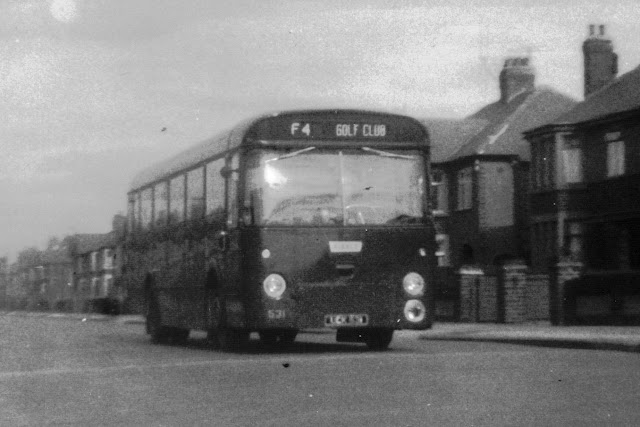 |
| Centre entrance PD2s 291 and 298 at the 'Showground' terminus of the three days a year service 17 in 1968. (Brian Turner) |
While many people are feel the number 13 brings bad luck, managers at Blackpool Transport would do well to be superstitious of the seemingly innocent 17. Like 13, 17 is a prime number but none of the variety of routes numbered 17 could ever have been said to reach their prime.
The first bus to display service 17 ran in May 1928. Intriguingly there is a link to Blackpool’s first bus route which was retrospectively allocated the dreaded number 13 in 1926. This ran from Cleveleys to Thornton Station from 1921 to 1930 but in July 1927 was extended to Burn Naze. Oddly in May 1928 the route was split with the new 17 operating the Thornton to Burn Naze section. It shared a terminus with the 14 from Blackpool and may have been interworked with it. A dismal £235 was taken in 5 months of operation – between £1 and £2 per day. Faced with a long and unremunerative winter, the plug was pulled from the end of November.
Attempt two started on 23 December 1929 and was an early Christmas present for the residents of the area being developed around the Welcome Inn in Marton. It was a somewhat circuitous route leaving Talbot Road Bus Station via Caunce Street, Devonshire Road and Newton Drive to reach Stanley Park then via Park Drive, Waterloo Road and Vicarage Lane to Welcome Inn. It was hardly a warm welcome, the 17 ceased on 5 May 1930 leaving the Welcome Inn without a bus service until 1933.
1929 also saw the introduction of a market day express service from Blackpool to Fleetwood which was initially un-numbered but was later allocated number 17. Its operation was best described as ad-hoc and was officially dropped in 1936. The number re-appeared in December 1939 to replace the Blackpool to Layton Station section of service 15A along Warbreck Hill Road and is believed to have survived throughout the war until the reinstatement of the 15A in 1946. The 17 was then reallocated in April 1946 to a new link from Layton to Victoria Hospital via Devonshire Road which was a temporary measure until service 22 was extended via the more direct and newly constructed Grange Road in November.
The sixth distinct service 17 made its debut on 15 May 1948 – with the first journey running nine years late. The new service had been scheduled to start in May 1939 but was postponed due to the impending war and it was not until 1948 that it could be implemented. It used just one bus and opened up what became the Mereside estate but was then known as Sandham’s Green. It followed the existing 6 route from Adelaide Street, Central Drive, Grasmere Road, Ansdell Road and Daggers Hall Lane to Welcome Inn before running via Chapel Road (even today one of Blackpool’s most rural roads) to Little Marton School at the junction of Clifton Road and Lee Road. Given that it sat on top of the established service 6 it probably didn’t earn much money on its own account, but was sufficient to protect Blackpool’s claim to serve Mereside as it developed as Ribble served the main Preston Road along the northern edge of the estate on its trunk routes to Preston.
It was renumbered 6C in December 1951 to associate itself with the 6 (which spawned A, B, C and D variants at one stage) and became Blackpool’s first one man operated bus service in 1955. Sadly the curse of the 17 wasn’t lifted by its renumbering and the route ended in 1956. Perhaps the bizarre 84-minute frequency offered latterly didn’t help.
Blackpool’s next flirtation with the 17 was probably its most successful thus far as it lasted for 18 years, yet ran for just three days per year. The annual Royal Lancashire Show was held on the old Aerodrome site which is now Blackpool Zoo and a special service was provided numbered 17. It started in 1953 and lasted until the show moved away in 1971 as the Zoo site was developed.
Jumping into the post deregulation era, Blackpool stocked up on minibuses in 1987 and decided to introduce local services in St. Annes and Bispham. While the former ran from June 1987 to February 1988, the latter only managed two months from December 1987. The Bispham service used four minibuses on a circular service to local housing estates Bispham running every 10 minutes each way as 17A and 17B – the penultimate of Blackpool’s short lived 17s.
Since this article was written in 2009 a new 17 has emerged. In June 2010 the 14 was split with the Blackpool to St. Annes section becoming route 17 and linked to the former 2 service between St. Annes and Lytham. The service ran half hourly, but the St. Annes to Lytham section was jettisoned to the equally rare number 18 in September 2010 and this too ended in January 2011 with a new Coastal Coaches tendered service 78 replacing it.
The 17 was reduced to hourly in June 2015 with service 10 extending to St. Annes to maintain the two buses per hour. In April 2016 both the 10 and 17 were extended to Poulton.
 |
| And for one week only, the unluckiest number of all - Solo 253 works a 17A shuttle from Spring Gardens to St. Annes due to a lengthy diversion for the 17 in February 2013. See post here (Brian Turner) |

























